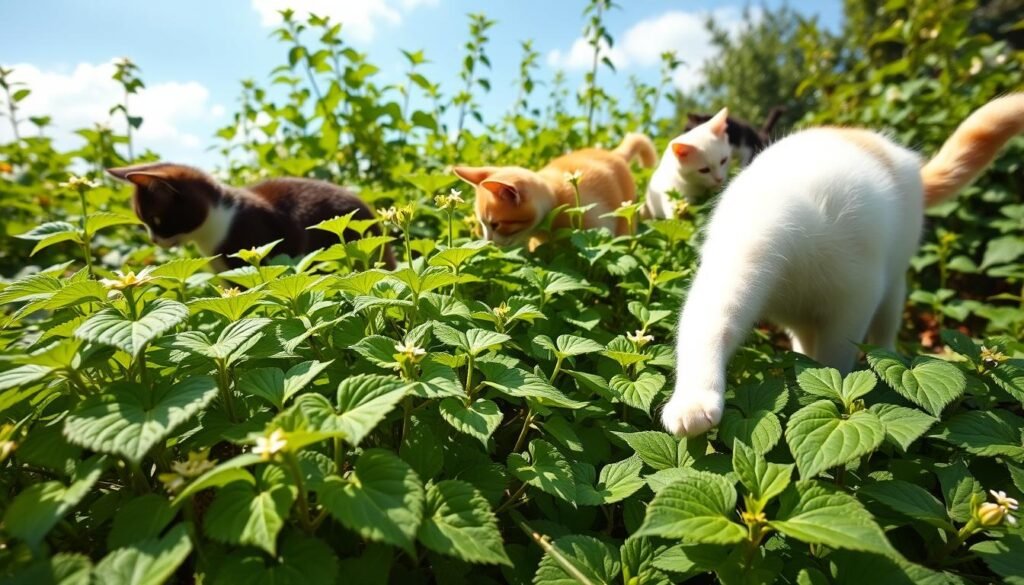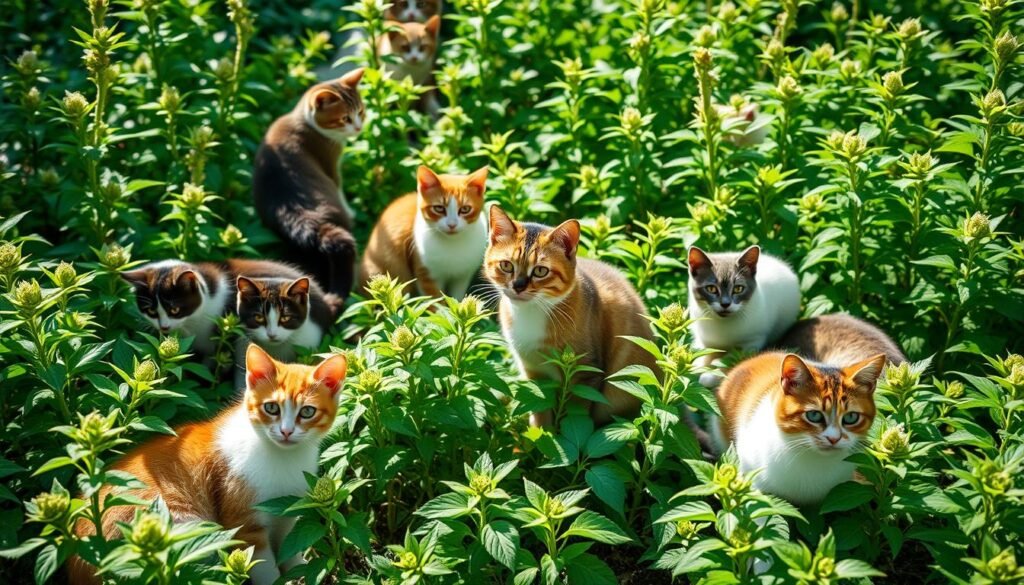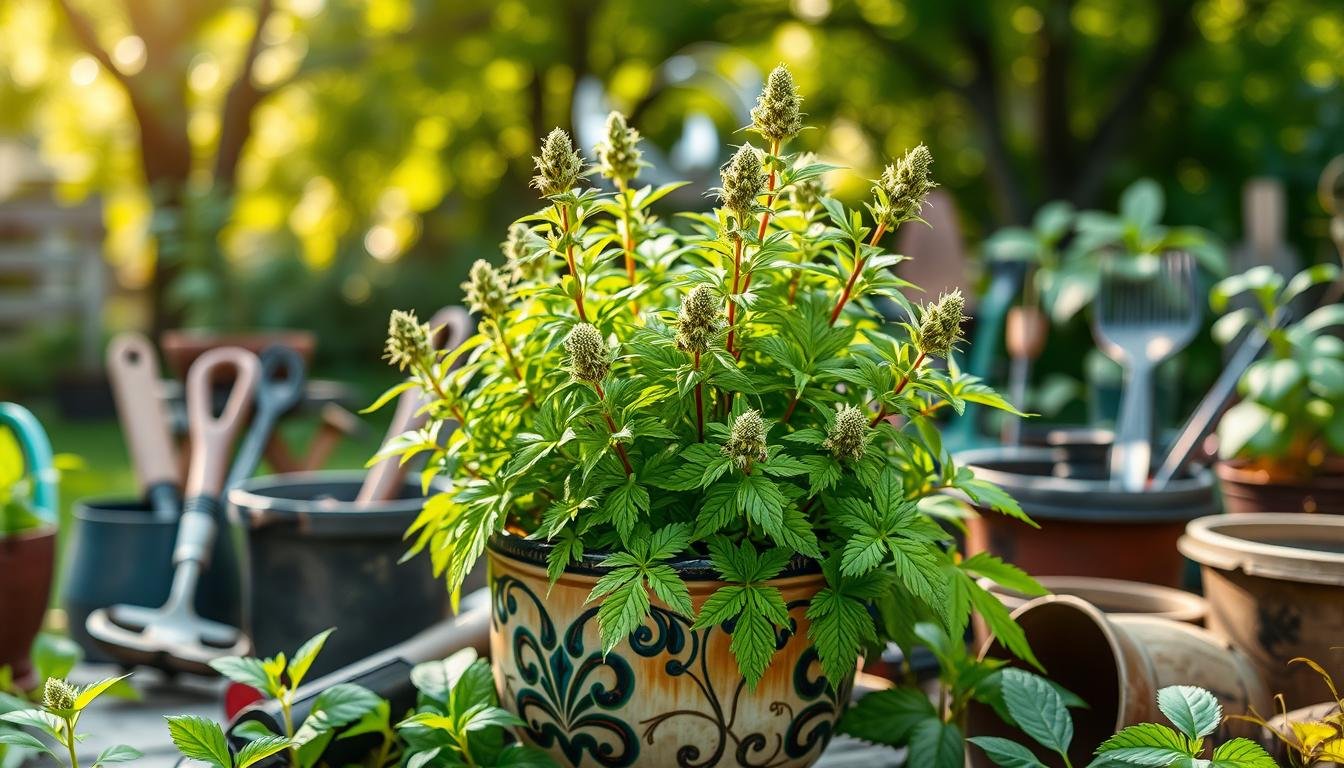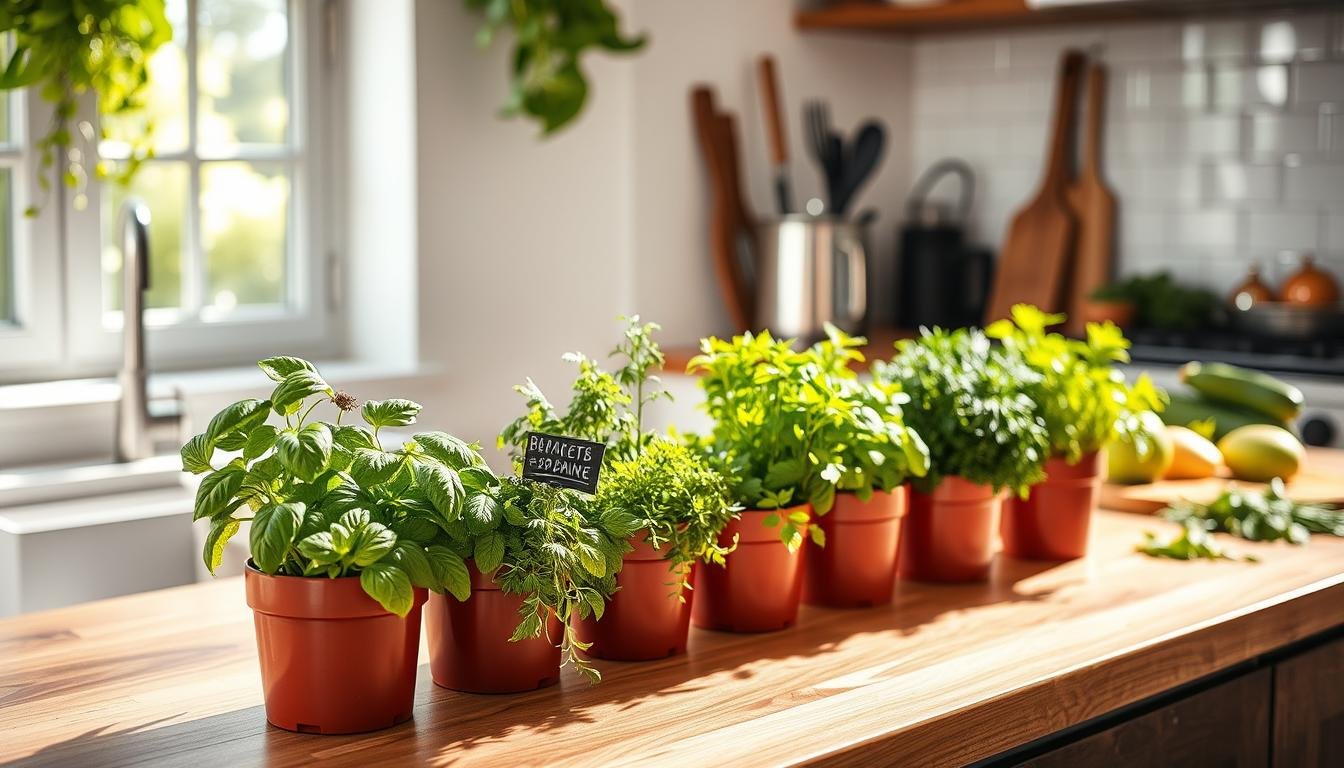Did you know about 70% of cats love catnip? This fact shows how much cats enjoy this herb. As more people grow catnip, you might wonder if it makes gardens more cat-friendly. Let’s dive into why catnip is appealing, how it helps your garden, and the joy of creating a space for cats. Imagine turning your garden into a place where beauty and playful cats come together.
Key Takeaways
- Growing catnip can attract various cats due to its appealing chemical compounds.
- Catnip plants are relatively easy to cultivate, making them perfect for garden enthusiasts.
- A cat-friendly garden can enhance the outdoor experience for both pets and their owners.
- Understanding the behavior of cats around catnip is key to maximizing its appeal.
- Creating a suitable environment for your cat can lead to hours of fun and enjoyment.
Understanding Catnip and Its Appeal
Catnip, known scientifically as Nepeta cataria, is a plant that intrigues many cat owners. It belongs to the mint family and is loved for its scent. This aroma is why it’s a top choice for attracting cats.
The secret of catnip lies in a compound called nepetalactone. This chemical makes cats feel super happy, making playtime more fun. However, not every cat reacts to catnip. Due to genetics, 50-70% of cats enjoy it, but others don’t care for it.
Adding cat mint to your garden can boost the fun for you and your pet. It helps cats and their humans connect more deeply. Playtime becomes more lively, and it creates joyful moments for everyone.
| Characteristic | Details |
|---|---|
| Scientific Name | Nepeta cataria |
| Family | Mint family |
| Main Compound | Nepetalactone |
| Reaction Rate | 50-70% of cats |
| Benefits | Fosters bonding, stimulates play |
What is Catnip? Exploring Nepeta Cataria
Nepeta cataria, or catnip, is part of the mint family. It is known for drawing cats like a magnet. The plant stands 2 to 3 feet tall and has green leaves with a special smell. This smell makes cats very happy and playful.
Nepeta cataria loves sun and does well in well-drained soil. It’s perfect for home gardens. With its lovely purple flowers in summer, it looks great outside.
Catnip is very tough and grows in many places. Gardeners like it because it’s easy to grow. Plus, it makes their cats very happy.

Catnip Gardening: Best Practices for Growing Catnip
Catnip gardening is a fun way to brighten up your garden and make your cats happy. To grow catnip well, paying attention to small details is key. Choose a sunny place in your garden for the catnip. It does best in full sunlight, needing around six hours of direct light daily.
The right soil is crucial for catnip to thrive. Soil that drains well and is rich in organic material helps the plants grow strong. Try to have a soil pH between 6.1 and 7.5. It’s also good to test your soil regularly to keep it in the best condition.
Watering your catnip the right way is very important. At first, make sure the soil stays moist but not too wet. After the catnip has grown a bit, it doesn’t need as much water. Depending on the weather, watering once a week is usually enough.
How you plant catnip matters a lot too. Make sure to give each seed or seedling enough space, about 12 to 24 inches apart. This stops them from getting too crowded. Less crowding means better air flow and less disease.
The timing of your planting can change how much catnip you get. Plant in the spring for the best results. Cutting the leaves often will make your plants grow more leaves, so don’t be shy about harvesting! For the tastiest and most fragrant leaves, harvest in the late morning when the dew has dried.
Using organic gardening practices is very important when cats are around. Stay away from strong pesticides and chemicals that could hurt cats and helpful bugs. Use safe options like neem oil or insecticidal soap if you have pest problems.
By following these guidelines, you’ll create a wonderful catnip garden. Your cats will have a great time, and you can enjoy the aromatic leaves too.
Will Growing Catnip Attract Cats? The Science Behind It
Many pet owners and gardeners wonder if growing catnip will draw cats. Studies have shown that cat behavior changes with catnip. The key compound, nepetalactone, affects cats when they crush the plant.
This can make cats roll, purr, and play more. It’s an interesting topic for those who love cats.
How Catnip Affects Feline Behavior
Cats react to catnip in various ways. Some get very energetic and playful. Others might become calmer or even sleepy.
This is because catnip can boost a cat’s mood. It’s a good way to entertain attracting felines. Yet, not all cats react to catnip. About 50-75% of cats show a response.
This variation is due to genetics and where they live. It’s a mix that influences how they react.
Factors Influencing Attraction to Catnip
Different things can affect a cat’s interest in catnip. Age, sex, and if they’ve been around it before matter. Young cats might not react as much as older ones.
Also, boy cats tend to show a stronger reaction than girl cats. Knowing this helps pet owners figure out why some cats love catnip and some don’t. It’s key for those wanting to attract felines to their garden.

Benefits of Catnip for Your Garden
Adding catnip to your garden does more than just make your cats happy. It plays a big part in creating a lively ecosystem. Its scented leaves attract cats, bees, and butterflies. These creatures help plants grow and make your garden flourish.
Catnip also keeps pests away. It has nepetalactone, which bugs like aphids and mosquitoes don’t like. So, planting catnip means you might not need chemical bug sprays. This makes your garden a better place for animals and pets.
Using catnip makes gardening easier and more eco-friendly. It’s tough, doesn’t need much care, and is good for the Earth. Catnip grows well in many conditions, even tough ones. This makes it a smart pick for green gardeners.
- Enhances biodiversity: Attracts pollinators and other beneficial wildlife.
- Pest control: Naturally deters harmful insects, reducing chemical usage.
- Low maintenance: Easy to grow and care for, suitable for beginners.
- Sustainable option: Promotes an eco-friendly gardening approach.
By adding catnip and planning well, you can make a great space for pets and nature. Catnip makes your garden look better, helps the environment, and cuts down on work. It’s an ideal choice for a cat-loving gardener.
Creating a Cat-Friendly Garden Environment
Making a garden safe and fun for cats is key to their happiness. Including climbing areas, shade, and soft spots makes a garden inviting for them. Adding scratching posts and safe walkways brings benefits like better exercise and brain health.
Other Feline Attractants to Consider
Besides catnip, other plants and herbs also draw cats in, offering them a world to explore. Here are some cat favorites:
- Valerian: Its smell can make cats playful.
- Lemongrass: This herb smells great and interests cats.
- Honeysuckle: The wood of this plant is fun for cats to play with.
Adding these plants can make your garden even more welcoming for cats. Each plant has its own way of appealing to cats. Make sure they’re planted right so they grow well. A good mix of plants turns your garden into a great place for your cats to play.
| Plant | Attraction Type | Ideal Growing Conditions |
|---|---|---|
| Valerian | Stimulating scent | Well-drained soil, full sun to part shade |
| Lemongrass | Fragrant leaves | Warm weather, full sun |
| Honeysuckle | Wood for scratching | Moist soil, full sun |
Using Catnip as a Natural Cat Treat
Catnip gives you a fun way to treat your cat with something they’ll love and benefit from. Natural cat treats made from catnip can make playtime better, wake up their senses, and help them feel comfy. Common ways to use catnip include dried leaves, toys with catnip, and homemade pillows filled with catnip.
It’s important to use catnip in moderation. Too much might overstimulate your cat. Start with a little and watch how your cat acts. Usually, 1-2 teaspoons of dried catnip are enough for a treat.
Check out these fun catnip ideas for your cat:
- Dried catnip leaves to sprinkle on scratching posts or beds
- Toys filled with catnip that make playtime fun
- Homemade pillows with catnip for cozy cuddling
Catnip doesn’t just make playtime fun. It can also help calm your cat. Many cats like how relaxing it is. Knowing the right way to use catnip means your cat can enjoy it without any problems.
| Catnip Treat Type | Benefits | Recommended Quantity |
|---|---|---|
| Dried Catnip Leaves | Stimulates playfulness | 1-2 teaspoons |
| Catnip-infused Toys | Encourages physical activity | N/A |
| Homemade Catnip Pillows | Provides comfort & relaxation | 1-2 teaspoons of catnip inside |
Choosing safe and fun catnip options means you’re making a loving space for your pets. You help them feel more at home.
Care and Maintenance of Catnip Plants
Keeping your catnip plants healthy is all about good catnip care. With the correct methods, you’ll have lush plants that draw in cats. Here’s how to grow catnip well:
- Pruning: Trim your plants often to get a fuller look. This stops them from getting too tall and thin.
- Fertilizing: Fertilize with balance in mind. Too much can make leaves grow but lose their scent.
- Watering: Water deeply but not too often. Let the soil dry a bit before watering again to avoid root problems.
- Disease Prevention: Watch out for pests like aphids and spider mites. Fight these with horticultural soap or neem oil.
Following these gardening tips will help your plants do well. Plus, you’ll enjoy how they attract and entertain your cats. With focus on growing catnip, your garden will soon be a haven for playful cats.
Common Challenges When Growing Catnip
Growing catnip can be a fun task. But, it also has its challenges. Gardeners may deal with pests and diseases that hurt their catnip plants. Knowing about these issues helps keep your cat-friendly garden doing well.
Pests and Disease Management
Dealing with pests is a big part of growing catnip. Creatures like aphids and spider mites attack these plants, causing leaves to change color and growth to slow. Using organic methods to fight pests can help a lot. You can bring in ladybugs or use insecticidal soap. These steps protect your plants.
Diseases can also harm your catnip. Root rot and powdery mildew are common problems. Root rot comes from too much water and bad drainage. It’s key to have soil that lets air through. Powdery mildew likes damp places, so it’s important to keep air moving around your plants. Taking steps such as not planting catnip too close together helps fight diseases.
| Common Pests | Symptoms | Control Methods |
|---|---|---|
| Aphids | Leaf curling, yellowing | Insecticidal soap, introduce ladybugs |
| Spider Mites | Webbing on leaves, speckled appearance | Water spray, neem oil |
| Common Diseases | Symptoms | Preventive Measures |
|---|---|---|
| Root Rot | Wilting, brown roots | Ensure well-draining soil, avoid overwatering |
| Powdery Mildew | White powdery spots on leaves | Good air circulation, avoid overcrowding |
Knowing the troubles of growing catnip is key. Being proactive in managing pests and diseases helps. This way, you can have a garden with healthy plants.
Exploring Other Herbs that Attract Felines
Catnip might be the top herb for cats, but other herbs also appeal to them. One such herb is cat thyme. It’s great for getting cats to play and does well in sunny spots with good drainage.
Lemon balm is another herb cats love. It’s not just for cats – people enjoy its mild lemon scent in teas and foods. It’s calming and adds a nice touch to any garden.
Adding different herbs to your garden is fun for your cats. Each herb needs different care and attracts cats in its own way. Try out various herbs to make your garden exciting for you and your cats.



